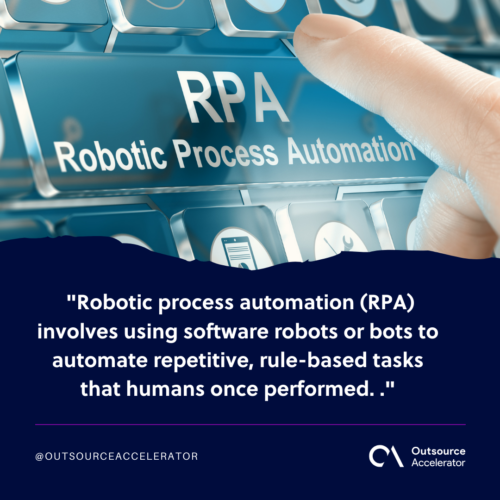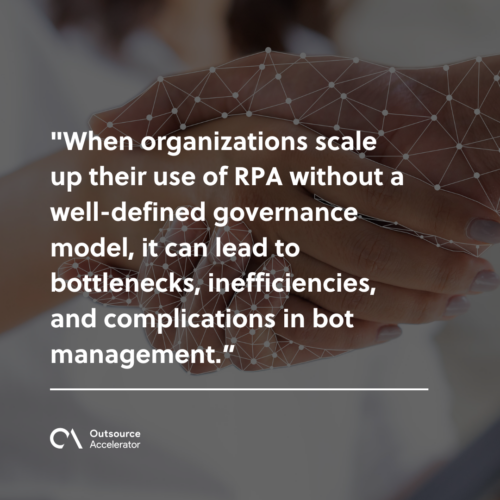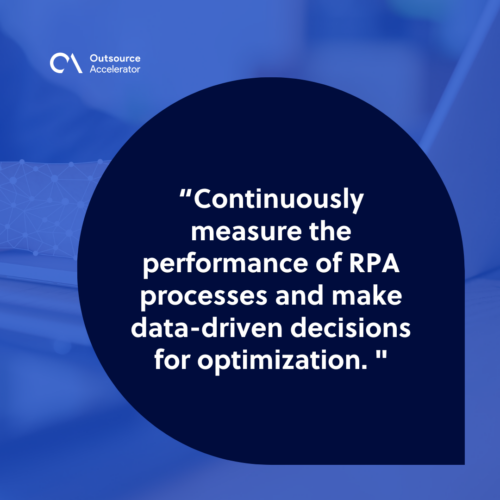8 RPA challenges and how to overcome them

Transformative technologies can revolutionize business operations. This is due to their capacity to fundamentally alter and enhance how organizational processes and value delivery mechanisms are structured.
Such technologies introduce innovative approaches that improve efficiency, productivity, and customer experiences, often leading to entirely new business models.
Additionally, new-gen techs enable businesses to streamline and automate repetitive, time-consuming tasks. This reduces the reliance on manual labor and the associated risks of errors.
Now, bringing the focus to robotic process automation (RPA), it has the potential to enhance data accuracy and enable organizations to make informed decisions.
However, there are some challenges associated with its integration. RPA often requires complex integration with existing systems, data sources, and processes.
Continue reading, and let’s explore these challenges and their solutions together.
What is RPA?
Robotic process automation (RPA) involves using software robots or bots to automate repetitive, rule-based tasks that humans once performed.
These robots interact with various software applications and systems, automating tasks and processes.
RPA follows predefined rules and workflows, making it suitable for automating routine, rule-based tasks.
It can extract and process data from various sources, perform calculations, generate reports, and communicate with other systems.
Robotic process automation is highly versatile and can be applied to various industries and functions, from finance and HR to customer service and supply chain management.

Legacy systems may use outdated technology or non-standard data formats, making it difficult for RPA bots to interact with and extract data seamlessly.
Additionally, data might be spread across various databases and locations, further complicating the integration process.
When RPA bots cannot easily access, process, and update data, it hinders the automation of critical business processes, limiting the technology’s potential to streamline operations.
Solution
Organizations should invest in RPA tools with strong integration capabilities to overcome RPA challenges.
Mapping out data flows, creating standardized data formats, and using middleware solutions can help bridge the gap between RPA bots and legacy systems.
Collaboration between IT and business teams is essential to ensure seamless data integration.
2. Process selection and prioritization
Selecting and prioritizing processes for automation is a complex decision-making process. It involves evaluating various factors, such as the following:
- Complexity of the task
- Potential for ROI
- Impact on business operations
Organizations must carefully assess which processes best suit automation, as not all processes are equally suitable.
This is one of the most complex RPA challenges that requires a thorough understanding of business operations and a clear strategy for automating processes.
RPA implementations may fail to deliver the expected value without a well-defined approach to process selection and prioritization.
Solution
To tackle this challenge, start by conducting a thorough process assessment, then do the following:
- Identify repetitive, rule-based, and time-consuming tasks that can benefit from automation.
- Prioritize processes that have a significant impact on efficiency and cost reduction.
- Create a clear roadmap for automation, starting with smaller, manageable tasks before tackling more complex ones.
3. Scalability issues
RPA challenges, in terms of scalability, may occur as organizations increase their reliance on bots to automate processes.
Managing a growing bot workforce while ensuring efficient and coordinated operations is a critical challenge.
When organizations scale up their use of RPA without a well-defined governance model, it can lead to bottlenecks, inefficiencies, and complications in bot management.
Without adequate scalability measures in place, the benefits of RPA can diminish as the system becomes harder to manage and optimize. This leads to increased operational complexities.
Solution
Implementing a well-defined governance model is crucial for managing scalability.
Centralize the management of RPA across the organization and establish clear guidelines for bot deployment.
Invest in RPA platforms that provide scalability features and can support a growing bot workforce. Regularly review and optimize bot performance to ensure efficiency.

Solution
Implementing a well-defined governance model is crucial for managing scalability. Centralize the management of RPA across the organization and establish clear guidelines for bot deployment.
Invest in RPA platforms that provide scalability features and can support a growing bot workforce. Regularly review and optimize bot performance to ensure efficiency.
4. Change management
Implementing RPA can often be met with resistance from employees concerned about job displacement.
The fear of automation replacing or making their roles redundant can lead to skepticism and apprehension within the workforce. Change management and workforce acceptance are critical RPA challenges.
Solution
Effective communication and change management strategies are essential to address employee concerns. Engage with employees to educate them on how RPA can complement their roles rather than replace them.
You may also provide training and upskilling opportunities to help employees work alongside bots. Encourage a culture of innovation and collaboration.
5. Compliance and security concerns
RPA processes sometimes introduce compliance and security issues, particularly when dealing with sensitive data.
One of the most pressing RPA challenges is ensuring that the bots adhere to regulatory standards and maintain data security.
The mishandling of sensitive information can lead to legal and financial repercussions.
Solution
Implement strict access controls, encryption, and audit trails to address compliance and security concerns.
Ensure RPA bots comply with relevant regulations, such as GDPR or HIPAA, and regularly update security measures.
6. Lack of standardization
The lack of standardization in processes and data across different departments or regions can hinder the successful implementation of RPA.
Moreover, inconsistencies in how tasks are performed and how data is structured make it difficult for bots to execute their tasks seamlessly and consistently.
Solution
Standardization efforts should be part of the RPA strategy. Implement clear and standardized processes across the organization, harmonizing data formats and procedures.
You may also create a centralized repository of process documentation and guidelines. This ensures that RPA bots can perform their tasks consistently regardless of the source.
7. Cognitive limitations
Cognitive limitations present a challenge in various professional settings, particularly when it comes to repetitive tasks.
Despite the automation process in place, it’s crucial to acknowledge that human cognitive abilities have their limitations, often resulting in RPA projects fail to meet expected outcomes.
RPA bots excel at executing repetitive, rule-based tasks with precision and efficiency. However, they struggle when confronted with tasks that require complex decision-making or understanding unstructured data.
These limitations can pose RPA challenges when attempting to automate processes that involve nuanced decision points or data that is not neatly structured.
Solution
Address cognitive limitations by integrating cognitive technologies, such as machine learning and natural language processing, into RPA solutions. T
This allows bots to handle more complex tasks by learning and adapting over time.
8. ROI measurement and cost issues
When analyzing ROI measurement and cost issues in the realm of RPA (Robotic Process Automation), it’s crucial to consider various factors to ensure an accurate assessment of the efficiency and effectiveness of an RPA project.
Calculating the return on investment for RPA initiatives can be complex. Various factors, including software licensing, hardware requirements, and ongoing maintenance costs, cause these challenges.
Accurately measuring the cost-effectiveness of RPA implementation and demonstrating its impact on the organization’s key performance indicators (KPIs) can be challenging.
Utilizing a reliable RPA tool can streamline processes, enhance productivity, and contribute to significant cost savings over time.
Overlooking the initial costs associated with implementing RPA systems, such as software licenses, training, and maintenance, can skew the ROI calculations.
Solution
Develop a comprehensive ROI framework that considers not only cost savings but also efficiency, accuracy, and employee satisfaction improvements.
Continuously monitor the performance of RPA processes and measure their impact on business KPIs.
Mitigate future RPA challenges in advance
While addressing the existing RPA challenges is crucial, it’s equally important to anticipate and mitigate future challenges proactively.
Here are some strategies to prepare for potential RPA challenges:
- Stay informed – Keep up with the latest developments in RPA technology and its applications. Awareness of emerging trends and solutions can help you adapt to future challenges.
- Invest in training – Regularly train your RPA teams and encourage them to enhance their skills. As RPA technology evolves, your team’s expertise should grow to meet new challenges.
- Collaborate – Foster collaboration between IT and business departments. An aligned approach ensures that RPA is applied strategically to meet business goals.
- Evaluate new tools – Periodically assess new RPA tools and platforms. Upgrading to the latest technologies can help you stay ahead of potential challenges.
- Measure and optimize – Continuously measure the performance of RPA processes and make data-driven decisions for optimization. This ensures that RPA continues to deliver value to your organization.

To effectively mitigate future challenges in RPA before they arise, it’s crucial to focus on a comprehensive strategy during the RPA implementation process.
By conducting thorough planning and risk assessments, organizations can anticipate and address potential obstacles in automation projects.
Allocating sufficient resources and expertise to RPA projects ensures successful outcomes and minimizes future setbacks.
Embracing intelligent process automation technologies can also enhance operational efficiency and adaptability, providing a competitive edge in today’s dynamic business landscape.
Furthermore, by staying prepared and proactive, you can tackle future RPA challenges and ensure the technology remains a valuable asset in your business toolkit.







 Independent
Independent




